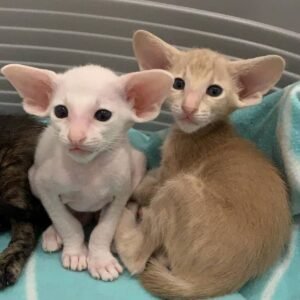Peterbald Cat for sale
Peterbald Cat for sale,a relatively new breed of cat, the Peterbald is a Russian-bred cat with a very complicated relationship with fur. Coming in a variety of coat colors and patterns, the Peterbald can have a coat of short hair, fine peach fuzz, or no hair—all of which can change throughout the cat’s lifetime.
But don’t let the coat fool you, these cats aren’t just a visual novelty. The Peterbald is a loving, affectionate, deeply loyal family cat breed that develops strong bonds with people and loves the company of other animals.
The Peterbald is a slim, muscular kitty characterized by a hair-losing gene inherited from its parent breed, Don Hairless, and the elegant appearance of the Oriental Shorthair. They are mistaken to be completely hairless, but there are actually five different variations of the coat accepted within the breed.
Peterbalds can be bald (no hair at all and slightly sticky to the touch) or have a flocked (90% hairless and chamois-like to the touch), velour (70% hairless with short, fine coat), brush (breed-specific wiry hair which is about 5mm long), or straight coat (regular, short coat and normal whiskers). Peterbalds that are born with fur may lose it over time. They have a slim, muscular body which highly resembles the body-type of Oriental Shorthairs.
Peterbald Cat Care
If your Peterbald has fur, maintenance is pretty simple. For downier coats, a rubdown once a week with a chamois or glove takes care of it. If your cat has hairless patches or is fully bald, then baths are going to be necessary, probably weekly. The natural oils in their skin and saliva will keep them moisturized and healthy, but regular bathing will keep those oils from building up and causing skin issues like acne.
Feeding can sometimes be a complicated issue for Peterbalds. They have a higher than average metabolism, with some owners reporting feeding them up to five times a day. This is one reason why Peterbald owners may choose to only feed their cats during specific windows throughout the day, rather than just leaving food out for them for the whole day; a tactic referred to as “free choice feeding.”
If you’re going to free choice feed, my recommendation is to only leave out their recommended daily caloric amount,” suggests Carol Margolis, DVM, DACT of the Gold Coast Center for Veterinary Care, on Long Island, N.Y.
“Once a cat is [spayed or neutered], cutting back by about 15 percent is probably going to be a good guideline, but it can be as much as 30 percent,” Margolis says.
Temperament
The Peterbald is an incredibly affectionate, playful cat. He gets along famously with humans of all ages, shapes, and sizes and loves to follow his bonded family around the house as they go about their day. He’ll also get along well with other cats and even dogs. Playtime with other animals and smaller children should be at least passively monitored, however, because all that exposed skin does make the Peterbald more susceptible to injuries like scratches and cuts, which will need to be disinfected and cleaned.
Since he trends towards the more vocal side, you’ll never wonder where your Peterbald is in the house, as he’ll be happy to describe his day to you in real time.
Health of Peterbald Cat
The biggest daily issue you’ll need to watch out for is your Peterbald’s skin. Too much direct sunlight can lead to sunburn, and prolonged exposure can open up the potential for skin cancers, so keeping them shaded and indoors is important.
“Cats are prone to melanomas, just like humans,” says Michelle Beck, DVM, CCRT, CVA, of the Backlund Animal Clinic in Omaha, Neb. “Sunscreen can definitely help, but in general, keeping them out of direct sunlight or indoors is going to be safer.Keeping any eye out for common cat maladies as they age, like kidney and heart disease, is important.
Appearance
The hair of the Peterbald cat for sale varies in texture, from a fuzzy velour coat to a completely “nude,” hairless body. There is even a “ultra-bald” type who has no whiskers or brows (and their skin often feels sticky to the touch).
Surprisingly, the coat of a Peterbald at birth may not be representative of its adult appearance. The coats of Peterbalds can change dramatically during their first two years of life. Their hair texture may change, as well as their hair growth and loss.













Reviews
There are no reviews yet.